Book contents
- Frontmatter
- Contents
- Contributors
- Preface
- 1 Evaluation of cognitive and behavioral disorders in the stroke unit
- Motor and gestural disorders
- Aphasia and arthric disorders
- Hemineglect, Anton–Babinski and right hemisphere syndromes
- Agnosia and Bálint's syndrome
- Executive and memory disorders
- Behavioral and mood disorders
- Dementia and anatomical left/right syndromes
- 31 Vascular dementia
- 32 Right versus left hemisphere syndromes
- Index
- References
31 - Vascular dementia
Published online by Cambridge University Press: 10 October 2009
- Frontmatter
- Contents
- Contributors
- Preface
- 1 Evaluation of cognitive and behavioral disorders in the stroke unit
- Motor and gestural disorders
- Aphasia and arthric disorders
- Hemineglect, Anton–Babinski and right hemisphere syndromes
- Agnosia and Bálint's syndrome
- Executive and memory disorders
- Behavioral and mood disorders
- Dementia and anatomical left/right syndromes
- 31 Vascular dementia
- 32 Right versus left hemisphere syndromes
- Index
- References
Summary
Introduction
Vascular dementia (VaD) is the second most common cause of dementia with a frequency ranging from 15% to 25% in autopsy and epidemiological studies (Tomlinson et al., 1970; Stevens et al., 2002). In addition, dementia is observed a few months post-stroke with prevalence as high as 25–33%, and about two-thirds of these patients meet the criteria of VaD (Tatemichi et al., 1993; Pohjasvaara et al., 1998). VaD may be a preventable type of dementia since it is due to vascular pathology and usually concerns patients with modifiable vascular risk factors. The diagnosis of VaD has several implications, including a high risk of stroke recurrence and mortality (Tatemichi et al., 1994b; Moroney et al., 1997b). VaD is due to several vascular pathologies, the most frequent being small vessel disease responsible for lacunes and leukoaraïosis (reported in about 40% of poststroke dementia) and multiple territorial infarcts. Because of the vascular mechanisms of underlying lesions, VaD is characterized by the frequency of stroke history, abrupt onset, stepwise deterioration, and the early presence of non-cognitive signs such as motor and perceptual deficits, gait disorders, speech and swallowing disorders, and incontinence. However a third of autopsy-confirmed VaD did not report stroke history and about a quarter presented with a progressive worsening (Moroney et al., 1997a). Although the neuropsychological pattern was found to be variable in an autopsy-confirmed VaD (Reed et al., 2004), most studies highlighted the prominence of executive dysfunction and response slowing.
- Type
- Chapter
- Information
- The Behavioral and Cognitive Neurology of Stroke , pp. 586 - 616Publisher: Cambridge University PressPrint publication year: 2007
References
- 2
- Cited by

